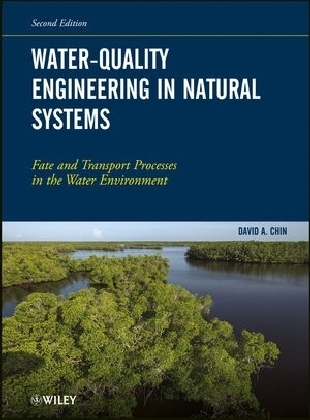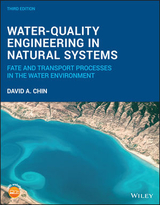
Water–Quality Engineering in Natural Systems
John Wiley & Sons Inc (Verlag)
978-1-118-07860-0 (ISBN)
- Titel ist leider vergriffen;
keine Neuauflage - Artikel merken
Detailing the fundamental equations that describe the fate and transport of contaminants in the environment, Water-Quality Engineering in Natural Systems covers the practical application of these equations to engineering design and environmental impact analysis relating to contaminant discharges into rivers, lakes, wetlands, ground water, and oceans. This second edition is thoroughly updated to include new topics on nutrient and pathogen models in streams as well as much more coverage of methods to calculate calculating total maximum daily loads (TMDLs). Numerous practical examples and end of chapter problems are included.
DAVID A. CHIN, PhD, is Professor of Civil and Environmental Engineering at the University of Miami as well as a registered Professional Engineer. Dr. Chin has published extensively, with important contributions on the fate and transport of contaminants in rivers, groundwater, oceans, and watersheds. His research interests also extend to wetland hydrology and vadose-zone hydrology. Dr. Chin is a recipient of the prestigious Collingwood Prize awarded by the American Society of Civil Engineers.
PREFACE xvii 1 INTRODUCTION 1 1.1 The Problem 1 1.2 Sources of Water Pollution 2 1.2.1 Point Sources 2 1.2.2 Nonpoint Sources 4 1.3 Control of Water Pollution 5 2 WATER QUALITY 7 2.1 Introduction 7 2.2 Physical Measures 7 2.2.1 Flow Conditions 7 2.2.2 Substrate 8 2.2.3 In-Stream Habitat 9 2.2.4 Riparian Habitat 9 2.2.5 Thermal Pollution 10 2.3 Chemical Measures 10 2.3.1 Dissolved Oxygen 10 2.3.2 Biochemical Oxygen Demand 12 2.3.3 Suspended Solids 14 2.3.4 Nutrients 15 2.3.5 Metals 17 2.3.6 Synthetic Organic Chemicals 18 2.3.7 Radionuclides 18 2.3.8 pH 19 2.4 Biological Measures 19 2.4.1 Human Pathogenic Microorganisms 20 2.4.2 Indicator Organisms 23 2.4.3 Biological Integrity 24 Problems 25 3 FUNDAMENTALS OF FATE AND TRANSPORT 27 3.1 Introduction 27 3.2 The Advection Diffusion Equation 27 3.2.1 Nondimensional Form 29 3.2.2 Transformation to the Diffusion Equation 31 3.2.3 Moment Property of the Diffusion Equation 32 3.3 Fundamental Solutions of the Advection Diffusion Equation 33 3.3.1 Diffusion in One Dimension 34 3.3.2 Diffusion in Two Dimensions 46 3.3.3 Diffusion in Three Dimensions 52 3.4 Transport of Suspended Particles 60 3.5 Turbulent Diffusion 62 3.5.1 Relationship of Turbulent Diffusion Coefficient to Velocity Field 63 3.5.2 Eulerian Approximation 65 3.6 Dispersion 68 Problems 72 4 RIVERS AND STREAMS 78 4.1 Introduction 78 4.2 Transport Processes 79 4.2.1 Initial Mixing 79 4.2.2 Longitudinal Dispersion 85 4.3 Models of Spills 90 4.3.1 Substances with First-Order Decay 90 4.3.2 Spills of Volatile Organic Compounds 93 4.4 Models of Dissolved Oxygen 95 4.4.1 Oxygen Demand of Wastewater 95 4.4.2 Reaeration 96 4.4.3 Streeter Phelps Model 98 4.4.4 Other Considerations 102 4.4.5 Chapra Di Toro Model 113 4.4.6 Empirical Models 116 4.4.7 Numerical Models 116 4.5 Models of Nutrients 116 4.6 Models of Pathogens 118 4.7 Contaminant Loads 119 4.7.1 Total Maximum Daily Loads 119 4.7.2 Long-Term Contaminant Loads 128 4.8 Management and Restoration 131 4.8.1 Nonstructural Techniques 131 4.8.2 Structural Techniques 132 Problems 134 5 GROUNDWATER 142 5.1 Introduction 142 5.2 Contaminant Sources 142 5.2.1 Septic Tanks 142 5.2.2 Leaking Underground Storage Tanks 143 5.2.3 Land Application of Wastewater 144 5.2.4 Irrigation Return Flow 145 5.2.5 Solid Waste Disposal Sites 146 5.2.6 Waste Disposal Injection Wells 146 5.2.7 Agricultural Operations 147 5.3 Fate and Transport Models 147 5.3.1 Instantaneous Point Source 149 5.3.2 Continuous Point Source 150 5.3.3 Continuous Plane Source 152 5.4 Transport Processes 154 5.5 Fate Processes 160 5.5.1 Sorption 160 5.5.2 First-Order Decay 165 5.5.3 Combined Sorption and Decay 167 5.5.4 Biocolloids 169 5.6 Nonaqueous Phase Liquids 170 5.6.1 Residual Saturation 171 5.6.2 Raoult s Law 172 5.7 Monitoring Wells 175 5.8 Remediation of Subsurface Contamination 179 5.8.1 Remediation Goals 180 5.8.2 Remediation Strategies 181 Problems 196 6 WATERSHEDS 203 6.1 Introduction 203 6.2 Urban Watersheds 203 6.2.1 Sources of Pollution 205 6.2.2 Fate and Transport Processes 208 6.2.3 Stormwater Control Measures 215 6.3 Agricultural Watersheds 224 6.3.1 Sources of Pollution 224 6.3.2 Fate and Transport Processes 226 6.3.3 Best Management Practices 236 6.4 Airsheds 240 Problems 241 7 LAKES AND RESERVOIRS 243 7.1 Introduction 243 7.2 Physical Processes 245 7.2.1 Circulation 245 7.2.2 Sedimentation 247 7.2.3 Light Penetration 248 7.3 Eutrophication 249 7.3.1 Biomass Nutrient Relationships 250 7.3.2 Measures of Trophic State 252 7.3.3 Depth of Anoxia 255 7.4 Thermal Stratifi cation 255 7.4.1 Layer Characteristics 257 7.4.2 Gravity Circulation 257 7.4.3 Water-Quality Impacts 258 7.4.4 Measures of Mixing Potential 259 7.4.4.1 Richardson Number 259 7.4.4.2 Densimetric Froude Number 260 7.4.5 Artificial Destratification 260 7.5 Water-Quality Models 261 7.5.1 Zero-Dimensional (Completely Mixed) Model 261 7.5.2 One-Dimensional (Vertical) Models 266 7.5.3 Two-Dimensional Models 272 7.6 Management and Restoration 275 7.6.1 Control of Eutrophication 275 7.6.2 Control of DO Levels 277 7.6.3 Control of Acidity 279 7.6.4 Control of Aquatic Plants 280 Problems 282 8 WETLANDS 286 8.1 Introduction 286 8.2 Natural Wetlands 286 8.2.1 Classifi cation 287 8.2.2 Delineation of Wetlands 289 8.2.3 Water Budget 291 8.3 Constructed Treatment Wetlands 292 8.3.1 Classification 293 8.3.2 Design of FWS Wetlands 295 Problems 305 9 OCEANS AND ESTUARIES 307 9.1 Introduction 307 9.2 Ocean Outfall Discharges 307 9.2.1 Near-Field Mixing 311 9.2.2 Far-Field Mixing 323 9.3 Estuaries 328 9.3.1 Classification of Estuaries 329 9.3.2 Water-Quality Issues 329 9.3.3 Salinity Distribution 330 9.3.4 Dissolved Oxygen: The Estuary Streeter Phelps Model 331 9.3.5 Flow and Circulation 334 Problems 337 10 ANALYSIS OF WATER-QUALITY MEASUREMENTS 340 10.1 Introduction 340 10.2 Probability Distributions 340 10.2.1 Properties of Probability Distributions 340 10.2.2 Mathematical Expectation and Moments 341 10.3 Fundamental Probability Distributions 342 10.3.1 Normal Distribution 342 10.3.2 Log-Normal Distribution 344 10.3.3 Uniform Distribution 345 10.4 Derived Probability Distributions 346 10.4.1 Chi-Square Distribution 346 10.4.2 Student s t Distribution 347 10.4.3 F Distribution 348 10.5 Estimation of Population Distribution from Sample Data 348 10.5.1 Sample Probability Distribution 349 10.5.2 Comparisons of Probability Distributions 350 10.6 Estimation of Parameters of Population Distribution 352 10.6.1 Method of Moments 352 10.6.2 Maximum Likelihood Method 354 10.6.3 Method of L-Moments 355 10.7 Probability Distributions of Sample Statistics 356 10.7.1 Mean 356 10.7.2 Variance 356 10.7.3 Coeffi cient of Skewness 357 10.7.4 Median 357 10.7.5 Coeffi cient of Variation 357 10.7.6 Useful Theorems 358 10.8 Confi dence Intervals 359 10.8.1 Mean 359 10.8.2 Variance 359 10.8.3 Variance Ratios 360 10.9 Hypothesis Testing 361 10.9.1 Mean 361 10.9.2 Variance 362 10.9.3 Population Differences 362 10.9.4 Normality 364 10.9.5 Trends 366 10.10 Relationships between Variables 368 10.10.1 Correlation 368 10.10.2 Regression Analysis 369 10.11 Functions of Random Variables 372 10.11.1 Addition and Subtraction 372 10.11.2 Multiplication 373 10.11.3 Division 374 10.11.4 Other Functions 375 10.12 Kriging 375 10.12.1 The Stationary Case 376 10.12.2 The Intrinsic Case 379 Problems 382 11 MODELING OF WATER QUALITY 387 11.1 Introduction 387 11.2 Code Selection 388 11.3 Calibration 388 11.3.1 Sensitivity Analysis 390 11.3.2 Performance Analysis 391 11.3.3 Parameter Estimation 398 11.4 Validation 401 11.5 Simulation 402 11.6 Uncertainty Analysis 402 11.6.1 Bayesian and GLUE Analyses 402 11.6.2 Monte Carlo Analysis 403 11.6.3 Analytical Probability Models 403 11.6.4 First-Order Uncertainty Analysis 404 A UNITS AND CONVERSION FACTORS 406 A.1 Units 406 A.2 Conversion Factors 408 B FLUID PROPERTIES 409 B.1 Water 409 B.2 Organic Compounds Found in Water 409 C STATISTICAL TABLES 411 C.1 Areas under the Standard Normal Curve 411 C.2 Critical Values of the t Distribution 413 C.3 Critical Values of the Chi-Square Distribution 413 C.4 Critical Values of the F Distribution ( = 0.05) 414 C.5 Critical Values for the Kolmogorov Smirnov Test Statistic 416 D SPECIAL FUNCTIONS 417 D.1 Error Function 417 D.2 Bessel Functions 417 D.2.1 Defi nition 417 D.2.2 Evaluation of Bessel Functions 418 D.3 Gamma Function 420 D.4 Exponential Integral 421 BIBLIOGRAPHY 422 INDEX 442
| Verlagsort | New York |
|---|---|
| Sprache | englisch |
| Maße | 215 x 290 mm |
| Gewicht | 1356 g |
| Themenwelt | Naturwissenschaften ► Biologie ► Ökologie / Naturschutz |
| Naturwissenschaften ► Chemie | |
| Technik ► Bauwesen | |
| Technik ► Umwelttechnik / Biotechnologie | |
| ISBN-10 | 1-118-07860-8 / 1118078608 |
| ISBN-13 | 978-1-118-07860-0 / 9781118078600 |
| Zustand | Neuware |
| Informationen gemäß Produktsicherheitsverordnung (GPSR) | |
| Haben Sie eine Frage zum Produkt? |
aus dem Bereich



